Performance Evaluation of Photovoltaic/Thermal (PV/T) System Using Different Design Configurations
Abstract
:1. Introduction
2. Research Methods
2.1. Mathematical Model
- (1)
- There is no change in the physical dimensions and material properties of the collector components.
- (2)
- For the parallel tube heat exchanger, temperature and flow rate in all tubes were taken as same.
- (3)
- The ohmic losses in the PV cells and edge losses are neglected.
- (4)
- All heat transfer coefficients were calculated in real-time [19].
- (5)
- Only the absorption loss of glass is taken into consideration.
- (6)
- For the glass-to-glass case, the glass cover2 serves as a sheet for the copper tube (carrying water), while for the glass-to-PV backsheet case, the PV backsheet works as a sheet for the copper tube considering famous sheet and tube configuration.
2.2. Exergy Analysis
2.3. Description of Proposed PV/T Systems
2.4. Model Validation
3. Results and Discussion
4. Conclusions
Author Contributions
Funding
Conflicts of Interest
Nomenclature
| surface area (m2) | |
| specific heat (J/kg °C) | |
| electrical power (W) | |
| exergy rate | |
| overall exergy gain | |
| solar radiation (W/m2) | |
| heat transfer coefficient (W/m2 °C) | |
| wind velocity (W/m2 °C) | |
| thermal conductivity (W/m °C) | |
| mass (kg) | |
| mass flow rate (kg/s) | |
| packing factor | |
| energy (W) | |
| useful energy gain (W) | |
| temperature (°C) | |
| & | tube inner & outer diameters |
| Nusselt number | |
| Reynolds number | |
| Prandtl number | |
| Greek | |
| absorptivity | |
| transmissivity | |
| thickness (m) | |
| stefan-boltzmann constant (W·m−2·K−4) | |
| efficiency | |
| emissivity | |
| primary energy saving efficiency | |
| Subscripts | |
| circulating air | |
| back panel | |
| bond or adhesive | |
| collector | |
| electrical | |
| circulating water | |
| glass cover1 | |
| glass cover2 | |
| & | outlet & inlet |
| PV backsheet or PVF film-based backsheet | |
| power plant | |
| solar cells | |
| tube | |
| thermal | |
| ambient air | |
References
- Jewell, J.; McCollum, D.; Emmerling, J.; Bertram, C.; Gernaat, D.E.; Krey, V.; Paroussos, L.; Berger, L.; Fragkiadakis, K.; Keppo, I. Limited emission reductions from fuel subsidy removal except in energy-exporting regions. Nature 2018, 554, 229. [Google Scholar] [CrossRef] [PubMed] [Green Version]
- Perea-Moreno, M.-A.; Hernandez-Escobedo, Q.; Perea-Moreno, A.-J. Renewable Energy in Urban Areas: Worldwide Research Trends. Energies 2018, 11, 577. [Google Scholar] [CrossRef] [Green Version]
- Chow, T.T. A review on photovoltaic/thermal hybrid solar technology. Appl. Energy 2010, 87, 365–379. [Google Scholar] [CrossRef]
- Charalambous, P.; Maidment, G.; Kalogirou, S.; Yiakoumetti, K. Photovoltaic thermal (PV/T) collectors: A review. Appl. Therm. Eng. 2007, 27, 275–286. [Google Scholar] [CrossRef] [Green Version]
- Taylor, R.A.; Phelan, P.E.; Otanicar, T.P.; Adrian, R.; Prasher, R. Nanofluid optical property characterization: Towards efficient direct absorption solar collectors. Nanoscale Res. Lett. 2011, 6, 1–11. [Google Scholar] [CrossRef] [Green Version]
- Hussain, M.I.; Ménézo, C.; Kim, J.-T. Advances in solar thermal harvesting technology based on surface solar absorption collectors: A review. Sol. Energy Mater. Sol. Cells 2018, 187, 123–139. [Google Scholar] [CrossRef]
- Bhattarai, S.; Oh, J.-H.; Euh, S.-H.; Krishna Kafle, G.; Hyun Kim, D. Simulation and model validation of sheet and tube type photovoltaic thermal solar system and conventional solar collecting system in transient states. Sol. Energy Mater. Sol. Cells 2012, 103, 184–193. [Google Scholar] [CrossRef]
- Rommel, M.; Zenhäusern, D.; Baggenstos, A.; Türk, O.; Brunold, S. Development of glazed and unglazed PVT collectors and first results of their application in different projects. Energy Procedia 2015, 70, 318–323. [Google Scholar] [CrossRef] [Green Version]
- Vats, K.; Tomar, V.; Tiwari, G.N. Effect of packing factor on the performance of a building integrated semitransparent photovoltaic thermal (BISPVT) system with air duct. Energy Build. 2012, 53, 159–165. [Google Scholar] [CrossRef]
- Hosseinzadeh, M.; Sardarabadi, M.; Passandideh-Fard, M. Energy and Exergy Analysis of Nanofluid Based Photovoltaic Thermal System Integrated with Phase Change Material. Energy 2018, 147, 636–647. [Google Scholar] [CrossRef]
- Shahsavar, A.; Ameri, M.; Gholampour, M. Energy and exergy analysis of a photovoltaic-thermal collector with natural air flow. J. Sol. Energy Eng. 2012, 134, 011014. [Google Scholar] [CrossRef]
- Saidur, R.; BoroumandJazi, G.; Mekhlif, S.; Jameel, M. Exergy analysis of solar energy applications. Renew. Sustain. Energy Rev. 2012, 16, 350–356. [Google Scholar] [CrossRef]
- Pathak, M.J.M.; Sanders, P.G.; Pearce, J.M. Optimizing limited solar roof access by exergy analysis of solar thermal, photovoltaic, and hybrid photovoltaic thermal systems. Appl. Energy 2014, 120, 115–124. [Google Scholar] [CrossRef] [Green Version]
- Tripanagnostopoulos, Y. Aspects and improvements of hybrid photovoltaic/thermal solar energy systems. Sol. Energy 2007, 81, 1117–1131. [Google Scholar] [CrossRef]
- Abu Bakar, M.N.; Othman, M.; Hj Din, M.; Manaf, N.A.; Jarimi, H. Design concept and mathematical model of a bi-fluid photovoltaic/thermal (PV/T) solar collector. Renew. Energy 2014, 67, 153–164. [Google Scholar] [CrossRef]
- Jarimi, H.; Bakar, M.N.A.; Othman, M.; Din, M.H. Bi-fluid photovoltaic/thermal (PV/T) solar collector: Experimental validation of a 2-D theoretical model. Renew. Energy 2016, 85, 1052–1067. [Google Scholar] [CrossRef]
- Baljit, S.S.S.; Chan, H.Y.; Audwinto, V.A.; Hamid, S.A.; Fudholi, A.; Zaidi, S.H.; Othman, M.Y.; Sopian, K. Mathematical modelling of a dual-fluid concentrating photovoltaic-thermal (PV-T) solar collector. Renew. Energy 2017, 114, 1258–1271. [Google Scholar] [CrossRef]
- Chow, T. Performance analysis of photovoltaic-thermal collector by explicit dynamic model. Sol. Energy 2003, 75, 143–152. [Google Scholar] [CrossRef]
- Hussain, M.I.; Lee, G.H. Thermal performance comparison of line-and point-focus solar concentrating systems: Experimental and numerical analyses. Sol. Energy 2016, 133, 44–54. [Google Scholar] [CrossRef]
- Hussain, M.I.; Lee, G.H. Numerical and experimental heat transfer analyses of a novel concentric tube absorber under non-uniform solar flux condition. Renew. Energy 2017, 103, 49–57. [Google Scholar] [CrossRef]
- Garg, H.P.; Adhikari, R.S. Transient simulation of conventional hybrid photovoltaic/thermal (PV/T) air heating collectors. Int. J. Energy Res. 1998, 22, 547–562. [Google Scholar] [CrossRef]
- Holman, J.P. Heat Transfer; Metric, S.I., Ed.; McGraw-Hill: New York, NY, USA, 1989. [Google Scholar]
- Agrawal, S.; Tiwari, G. Energy and exergy analysis of hybrid micro-channel photovoltaic thermal module. Sol. Energy 2011, 85, 356–370. [Google Scholar] [CrossRef]
- Singh, S.; Agrawal, S.; Avasthi, D. Design, modeling and performance analysis of dual channel semitransparent photovoltaic thermal hybrid module in the cold environment. Energy Convers. Manag. 2016, 114, 241–250. [Google Scholar] [CrossRef]
- Joshi, A.S.; Tiwari, A.; Tiwari, G.N.; Dincer, I.; Reddy, B.V. Performance evaluation of a hybrid photovoltaic thermal (PV/T)(glass-to-glass) system. Int. J. Therm. Sci. 2009, 48, 154–164. [Google Scholar] [CrossRef]
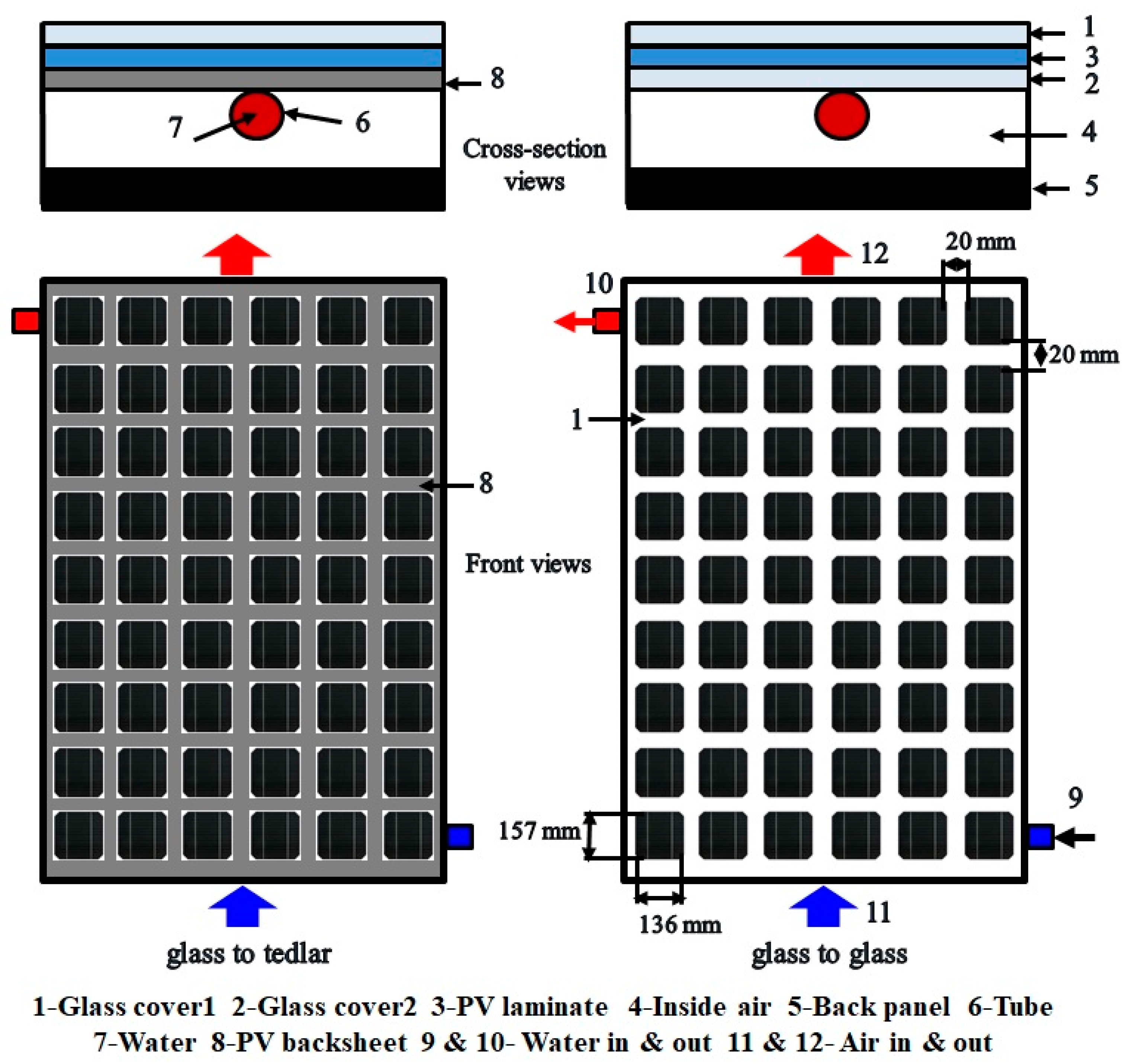
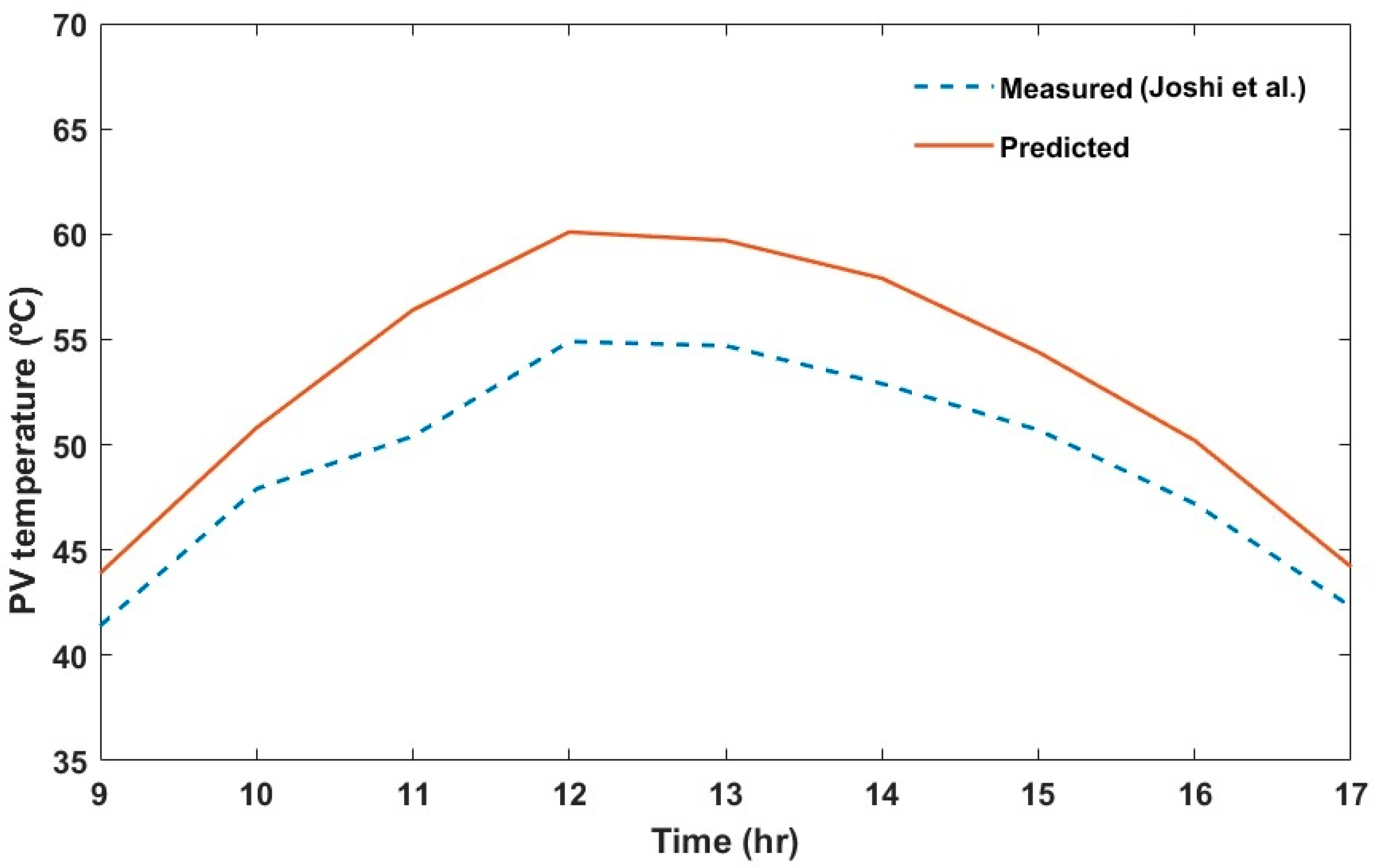
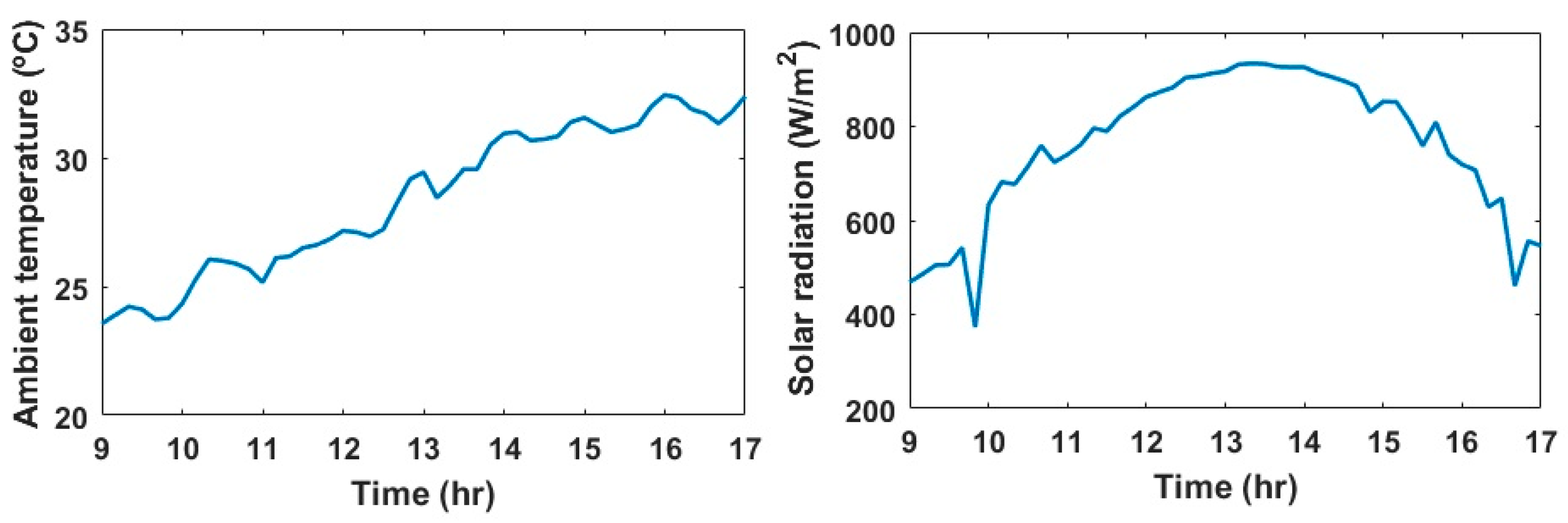
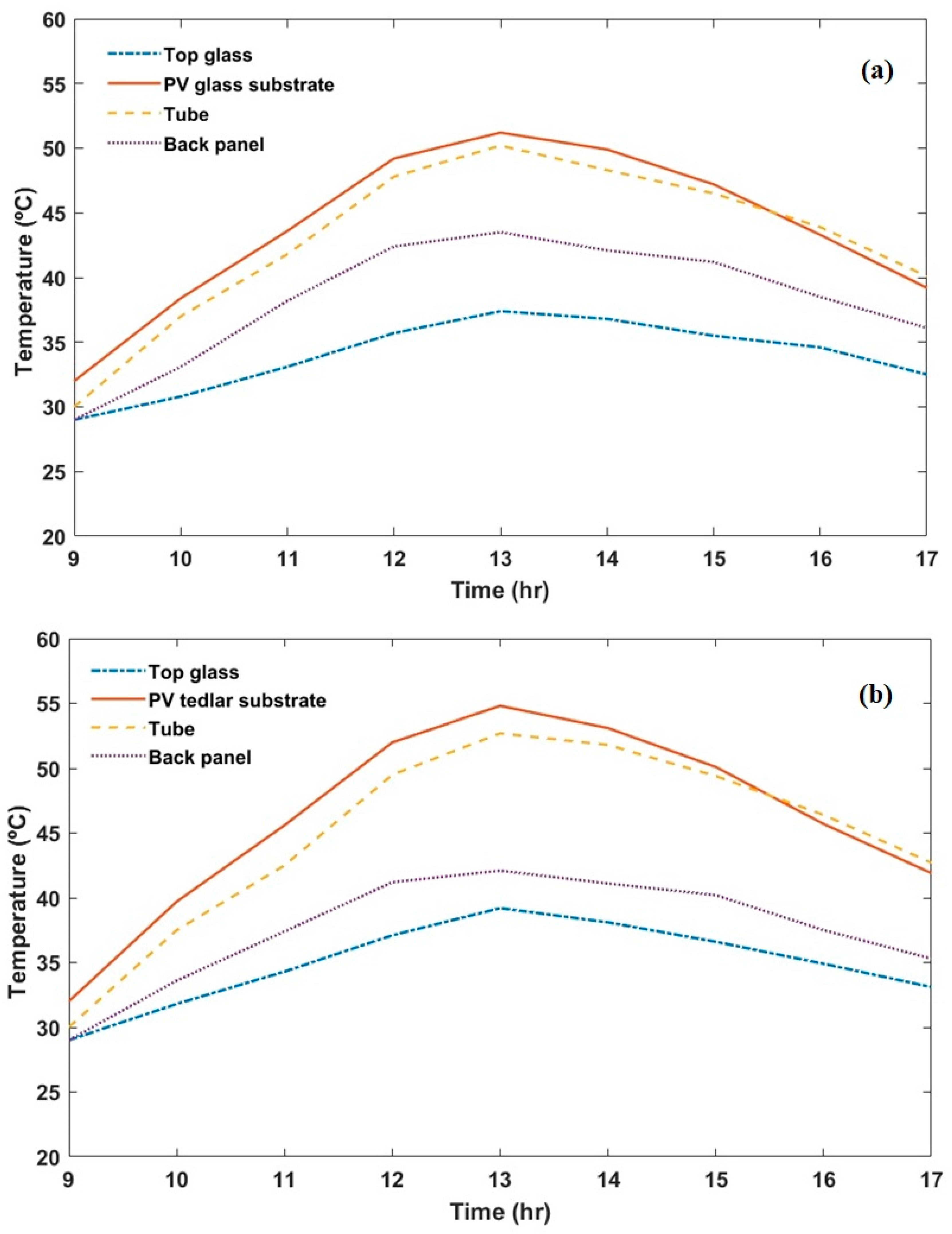
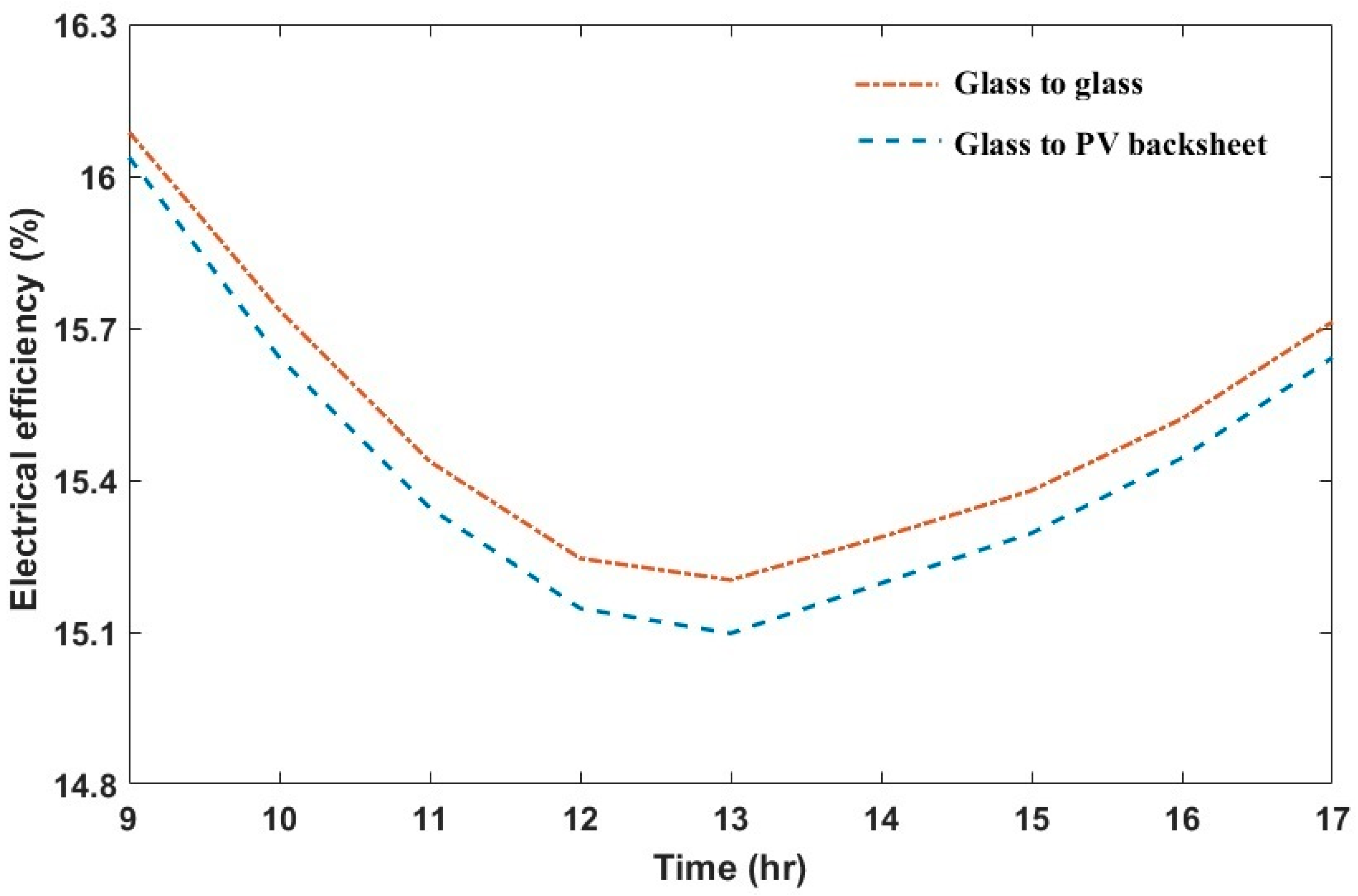
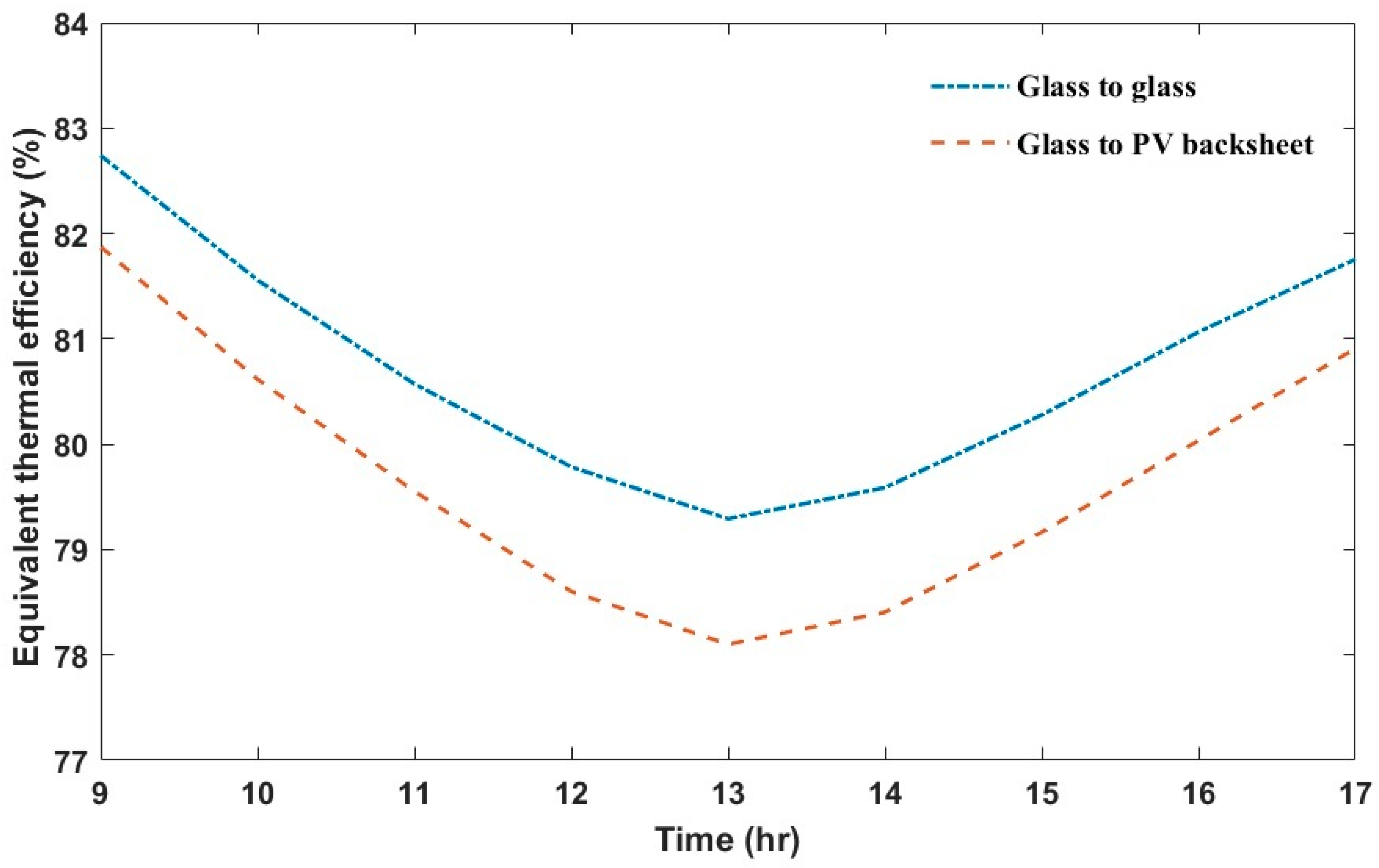
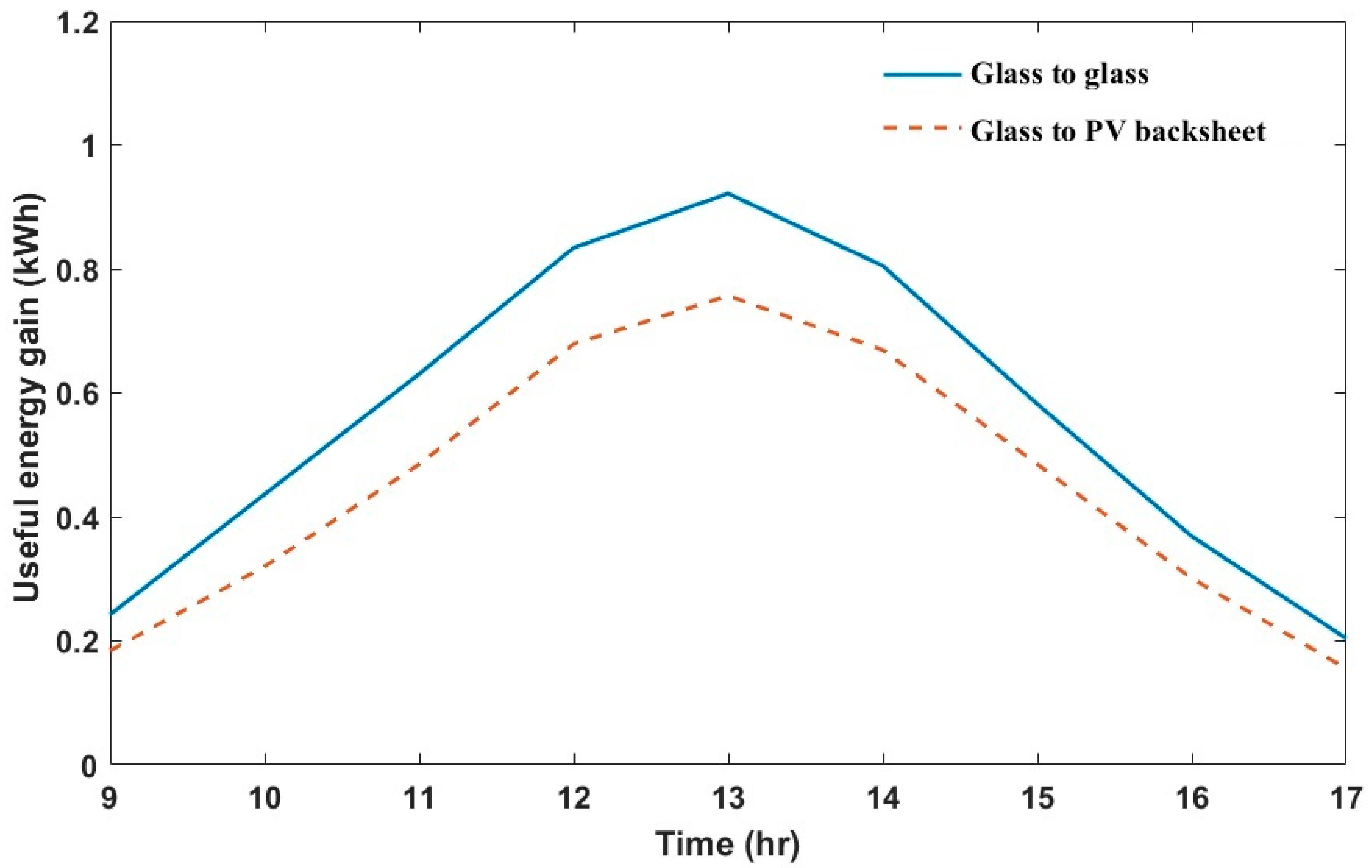
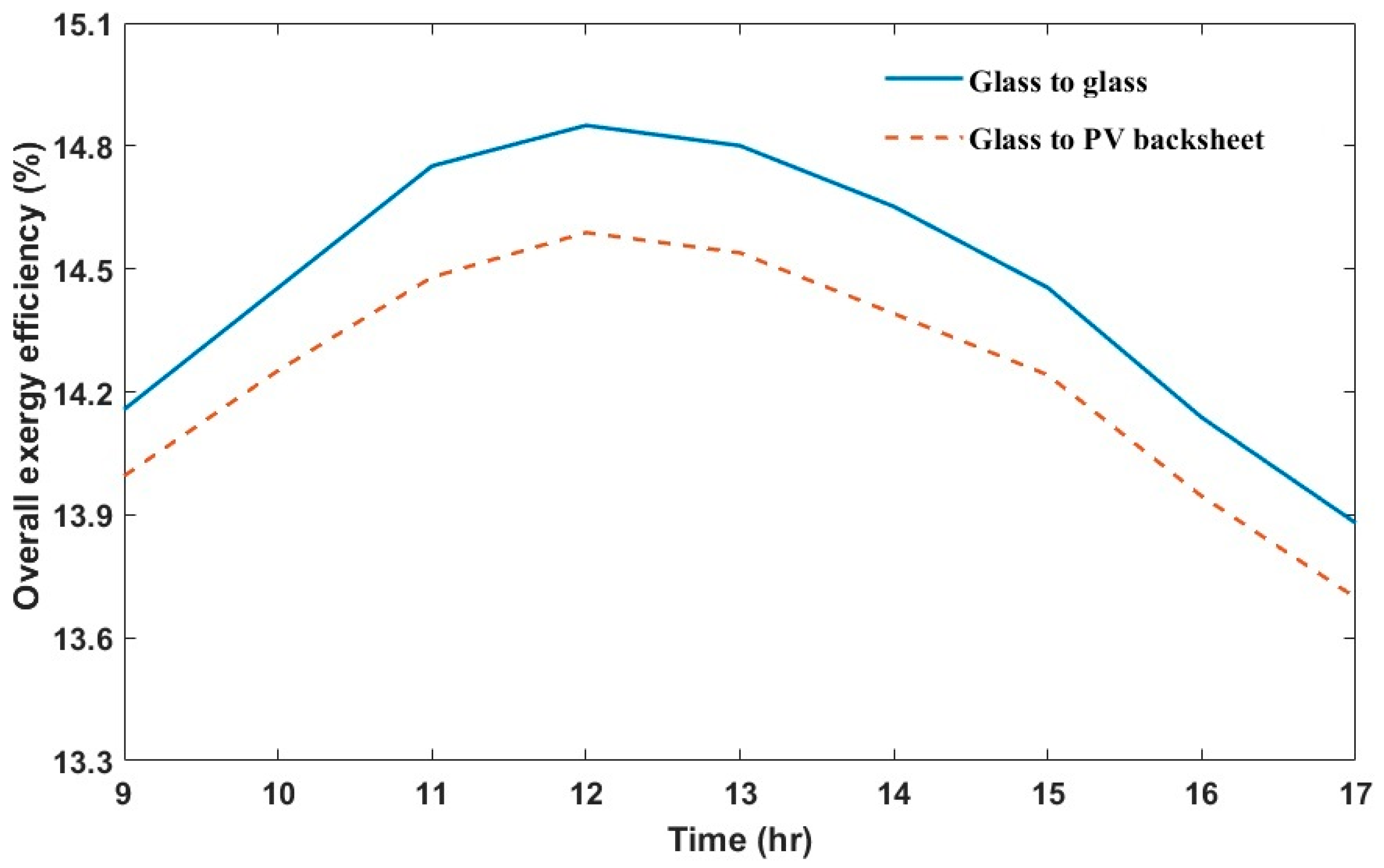
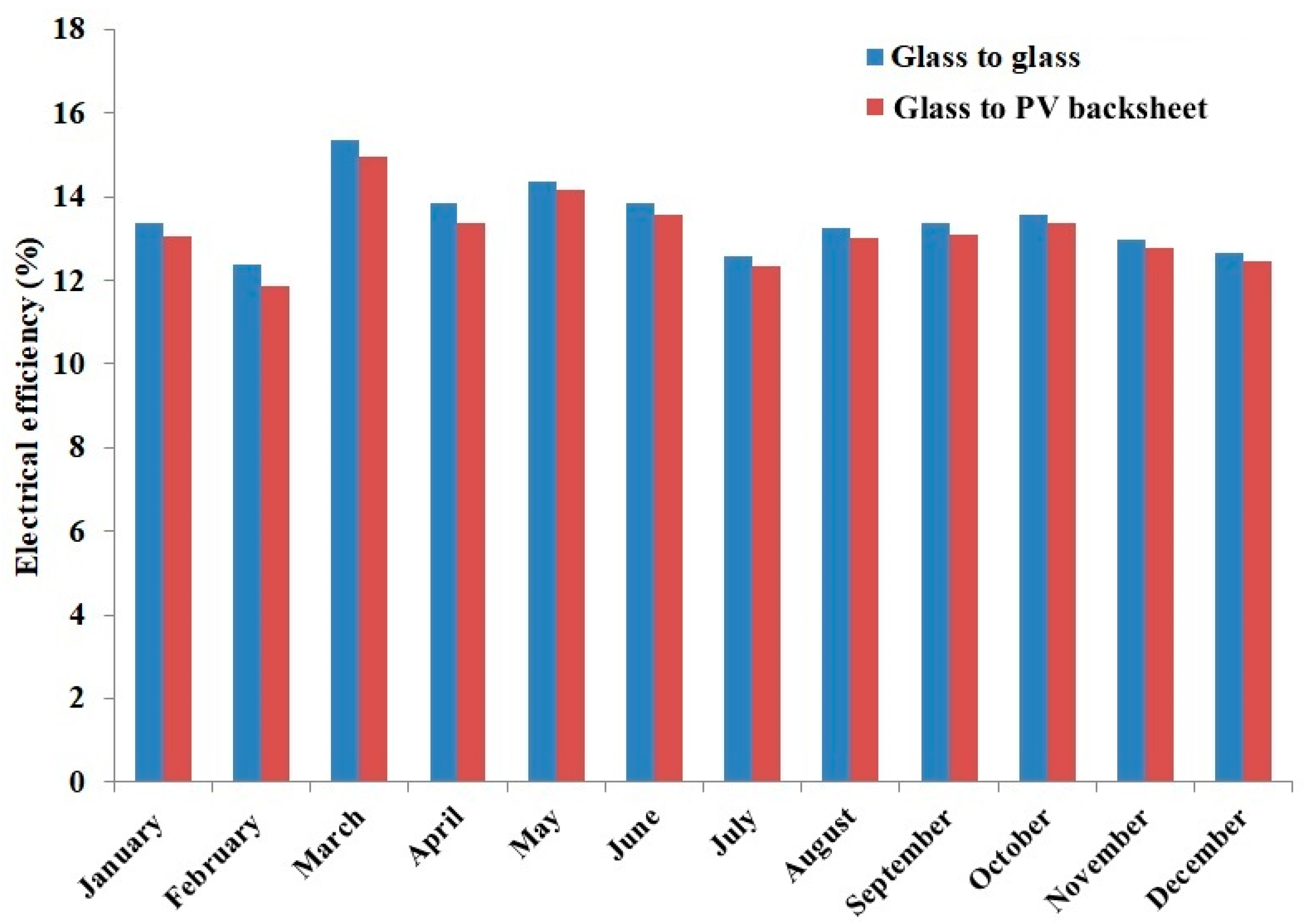

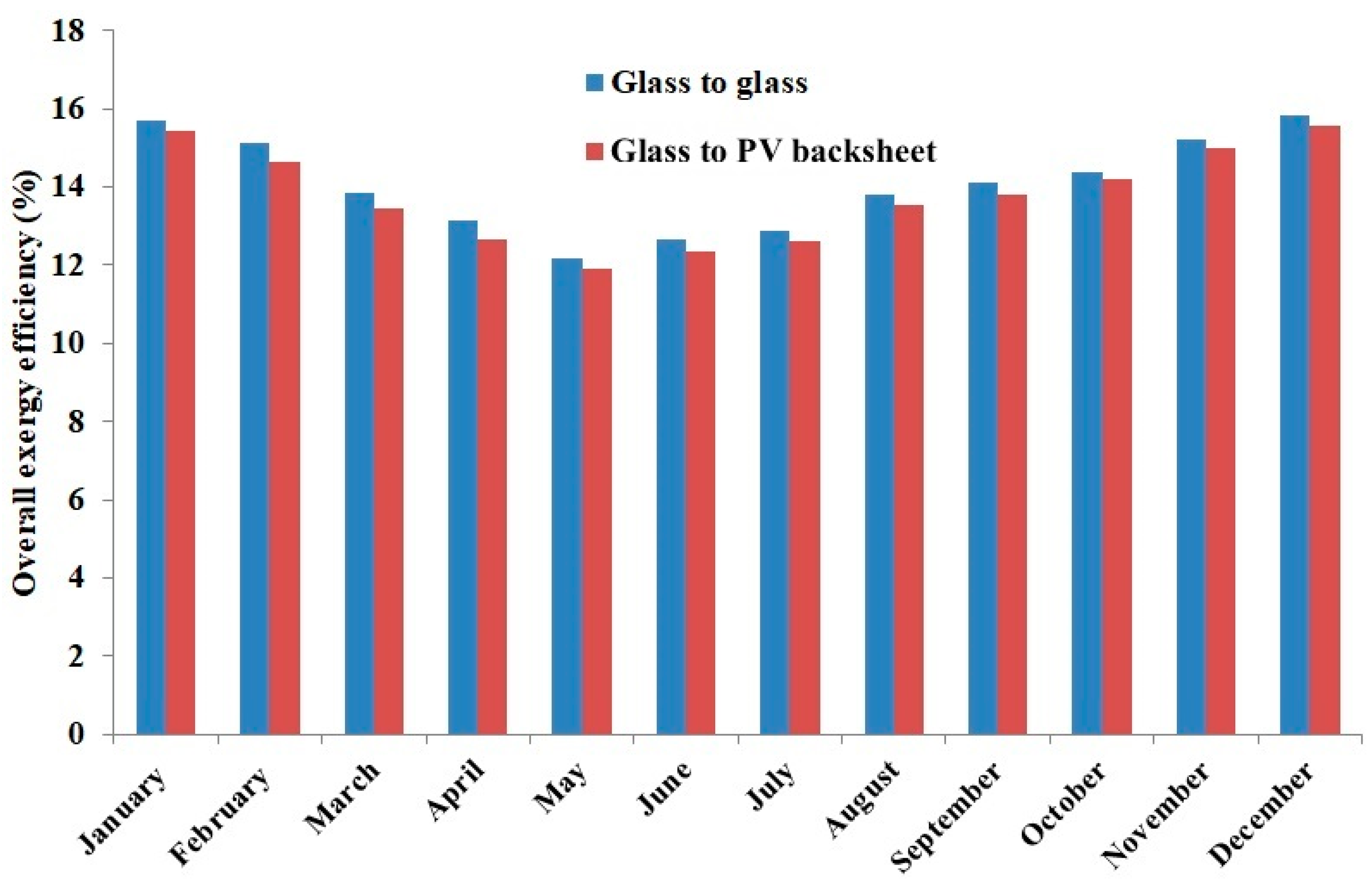
| PV cells [17] | Length & width | 1.62 m & 0.98 m |
| Absorptivity | 0.9 | |
| Emissivity | 0.88 | |
| Specific heat | 900 J/(kg K) | |
| Temperature coefficient | 0.0045/°C | |
| Reference PV panel temperature | 298.15 K | |
| Thickness of EVA+PV cells | 1.2 mm | |
| Thermal conductivity | 148 W/(m K) | |
| Glass cover | Glass solar transmittance | 92% |
| Thickness of tempered glass | 3 mm | |
| Specific heat | 670 (J/kg) | |
| Density | 2200 (kg/m3) | |
| Extinction coefficient | 26 (/m) | |
| PV backsheet | Thickness of PV backsheet | 0.5 mm |
| Thermal conductivity | 0.2 W/(m K) | |
| Absorptivity of PV backsheet | 0.5 | |
| Copper tube | Inner diameter | 0.008 m |
| Thickness | 0.0012 m | |
| Specific heat | 903 J/(kg K) | |
| Density | 2702 kg/m3 | |
| No. of tubes | 9 | |
| Tube spacing | 0.11 m | |
| Material | Copper | |
| Back panel | Density | 1520 kg/m3 |
| Specific heat | 840 J/(kg K) | |
| Thermal conductivity | 0.134 W/(m K) | |
| Thickness of back panel | 4 mm | |
| Fluids used | Water & air | - |
Publisher’s Note: MDPI stays neutral with regard to jurisdictional claims in published maps and institutional affiliations. |
© 2020 by the authors. Licensee MDPI, Basel, Switzerland. This article is an open access article distributed under the terms and conditions of the Creative Commons Attribution (CC BY) license (http://creativecommons.org/licenses/by/4.0/).
Share and Cite
Hussain, M.I.; Kim, J.-T. Performance Evaluation of Photovoltaic/Thermal (PV/T) System Using Different Design Configurations. Sustainability 2020, 12, 9520. https://doi.org/10.3390/su12229520
Hussain MI, Kim J-T. Performance Evaluation of Photovoltaic/Thermal (PV/T) System Using Different Design Configurations. Sustainability. 2020; 12(22):9520. https://doi.org/10.3390/su12229520
Chicago/Turabian StyleHussain, M. Imtiaz, and Jun-Tae Kim. 2020. "Performance Evaluation of Photovoltaic/Thermal (PV/T) System Using Different Design Configurations" Sustainability 12, no. 22: 9520. https://doi.org/10.3390/su12229520
APA StyleHussain, M. I., & Kim, J.-T. (2020). Performance Evaluation of Photovoltaic/Thermal (PV/T) System Using Different Design Configurations. Sustainability, 12(22), 9520. https://doi.org/10.3390/su12229520






